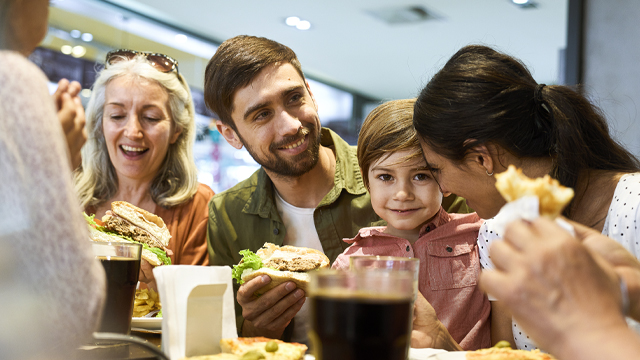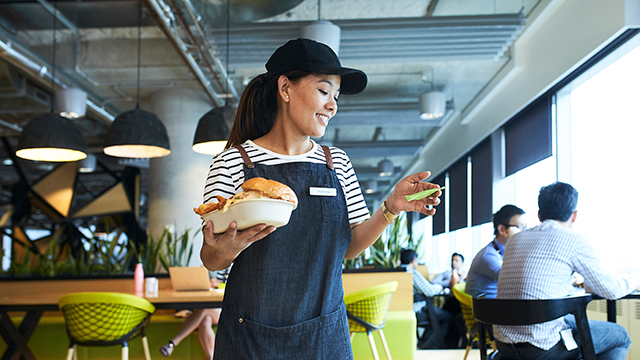Lowering costs and improving customer satisfaction
From ordering via apps and restaurant kiosks to consumer loyalty programs, today’s technology can dramatically improve how your QSR does
7 minute read
Key takeaways
- Customer personalization and labor productivity are two key areas where operators are seeing revenue improvements by using technology.
- With three-quarters of QSR customers eating off premises, operators are deploying technology to make ordering and delivery more efficient.
- Data analytics are helping operators customize their relationship with consumers to target special offers, remember individual food preferences and reward loyalty.
With costs rising and consumers expecting more personalized food orders, restaurants are increasingly turning to technology to improve productivity and enhance the customer experience. Annual technology budgets for quick-serve restaurant (QSR) chains range from 7% to 10% of revenue, according to Bank of America Global Research’s report, “What’s cooking in restaurant tech/POS?,” and expenditures continue to grow.1
The primary focus of these technology investments is to improve the consumer journey — to better serve the ways in which dining behavior and expectations have changed. According to the National Restaurant Association, three-quarters of QSR meals are now consumed off premises.2 Operators have invested heavily in proprietary apps and systems that make ordering food for pickup or delivery smooth, accurate and frictionless. Restaurants are also using data analytics to create personalized offers for their customers in real time, helping to build loyalty and increase their share of the dining wallet.
Beyond the customer experience, restaurants are increasing spending on technology that helps optimize their operations and strategy. Technology is playing a role in minimizing labor expenses — from automating repetitive tasks to hiring talent and organizing staff schedules and enabling more efficient and effective data-driven approaches to everything from inventory management to pricing and store layout. “Franchises use data analytics in supply chain management, new product development — just about every way you can think of,” says Cristin O’Hara, head of Bank of America Global Commercial Banking’s Restaurant Group.
Here’s what QSRs are doing with tech right now.

Nearly 60% of adults — and 74% of millennials — say they order restaurant meals with their mobile devices.3 QSRs are investing in a variety of digital technologies that can provide a seamless online and offline experience and offer greater personalization and customization.
Chatbots. Intelligent chatbots with advanced speech recognition capabilities are being deployed to take orders and offer suggestions in a variety of languages, speeding transactions and shifting this work from store employees.
Mobile apps. More and more chains have developed branded mobile apps that not only make ordering easy for the consumer but also help gather data about overall ordering patterns — what items are being ordered, at what time of the day and by what kind of consumers — as well as preference data for individual customers that can be used for customization and loyalty programs.
Delivery. Third-party delivery accounts for an increasing share of QSR traffic despite platform fees that range from 15% to 30% of meal costs. “Working with third-party delivery services can expand a restaurant’s reach and provide its customers with the benefit of delivery,” says Shannon O’Donnell, senior merchant specialist with Bank of America Global Payment Solutions. “But whether to absorb that upcharge or attempt to pass the cost on to consumers is a strategic decision that restaurants face.” Some restaurants have responded by launching their own delivery platforms that automatically sequence orders and issue routes to drivers to ensure meals are delivered quickly (the No. 1 customer priority), accurately, and at the right temperature.
Customization. Technology can help QSRs offer greater customization and personalization to enhance the customer experience and build loyalty. For example, based on an individual’s order history, the app can offer a special discount on a menu item that the consumer frequently buys. Or customers can specify preferences that will automatically be applied to orders, such as no onions or extra ketchup. The system can also make formal loyalty programs easier to use and manage, increasing participation.
Loyalty programs. Apps and online ordering platforms create new opportunities for expanding loyalty programs, which have proven highly lucrative in the QSR sector. According to one estimate, a 5% increase in customer retention from loyalty programs can deliver a potential boost of 25% to 95% in profits.4

High costs, frequent turnover and labor shortages are perennial issues for the restaurant business. With labor costs averaging nearly 30% of gross sales,5 finding ways to use less labor or to help the staff be more productive has become increasingly important. Technology is helping address these challenges in many ways, ranging from scheduling and hiring to kitchen robotics.
Automation. In the front of the store, kiosks, intelligent chatbots and touchless payments (including QR code payments) make ordering and paying faster, more accurate and less labor-intensive. In the kitchen, intelligent machines and robotic equipment are becoming more common. There are robotic grills and even machines that can peel and dice avocados.6
Staff management. In good times and bad, hiring and retaining talent is a challenge for restaurants. This is another area where technology is helping. In a National Restaurant Association survey, 37% of restaurant operators reported plans to invest in automated labor management, recruitment and scheduling systems.7 In hiring, companies are using chatbots to interact with applicants, reducing hiring times and streamlining applicant management. Some QSRs are allowing job seekers to apply via QR codes and texting. Employee management systems can use data analytics to spot risks, such as likelihood of quitting, and identify candidates for promotion.

The ultimate payoff from tech investments is to transform into fully digital enterprises. This means thoroughly using the data that’s being collected and linking various systems to create a connected, digitally enabled enterprise. The companies that can create a synthesis between data, automation and humans will be the most likely to achieve value.
Useful data stacks. “The industry has done a good job investing in digital technology and data,” says O’Hara. “Now restaurants need to figure out ways to use the data generated by all the equipment they’re using and the cards they’re swiping. It’s not just about collecting data but about using it.” To break down data silos and make it possible for data to be accessed and shared by multiple applications and departments, restaurants are building so-called data stacks — sets of tools that collect, store and analyze data from across the organization.
Integrated, end-to-end processes. Like other businesses, restaurants have built dedicated systems for specific processes and functions — point of sale, enterprise resource planning (ERP) and finance, to name a few. To maximize the payoff from technology investment, companies are finding ways to integrate these systems. This is an area where AI can help, says Melanie Whitlock, treasury sales officer at Bank of America Global Payments Solutions group. “AI helps merge payments with the banking platform and integration with ERP systems,” she says. “We’re seeing increasing investment in payment instant messages and instant final payments with QSRs and smaller clients as well.”
Predictive analytics. By analyzing historical data, restaurants can predict certain key events or opportunities. For example, a store can use predictive analytics to precisely identify which items will be most in demand the night of the local high school’s homecoming football game — or which items won’t be needed on a holiday when traffic is thin. Predictive analytics can be used for everything from demand forecasting to dynamic pricing and personalized marketing.
Data-driven floor plans. Restaurants need floor plans that reflect the how stores are used today. Using data analytics, chains are expanding counter areas and adding dedicated areas for mobile order pickups. Outside, they are adding drive-through lanes for pickup. Inside, they are shrinking or even eliminating dining space and opting for more flexible, modular seating.
The QSR business has been at the forefront of technological innovation, which has enabled it to adapt successfully to seismic changes in the business. Now companies are using these investments to create a competitive advantage. The restaurants that are first with innovative uses of data and digital machines will be the leaders and the companies best positioned to navigate the shoals of an uncertain economy.
LET’S TALK
Bank of America has a dedicated team of experts that can help you with any of these strategies and more as you grow (or exit) this industry. Feel free to contact your banker and discuss your upcoming plans.
1BofA Global Research, “What’s cooking in restaurant tech/POS?,” June 30, 2023
2Chain Store Age, “Survey: Three-quarters of restaurant meals consumed off-premises,” Apr. 16, 2025
3Hospitality Technology, “REPORT: 75% of Restaurant Transactions Are Off-Premises,” Apr.16, 2025
4Harvard Business Review, “The Value of Keeping the Right Customers,” Oct. 2014.
5Restaurant365,“How To Calculate Labor Costs: Key Metrics For Restaurants,” 2025.
6Reuters, “U.S. fast-food chains add automation to boost speed,” Aug. 2, 2023
7National Restaurant Association, “Research Insight: Workforce Technology,” March 2025
Restaurant Group
Explore powerful solutions for owners and operators.




